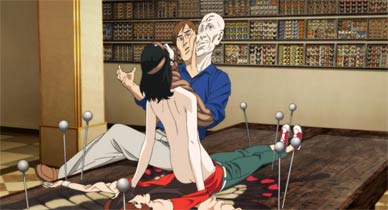only magazine
↵ home
Paprika

By Adam Thomas
Friday June 15, 2007
Drawing lines beyond reality
With any form of animation the possibilities of creation are endless. Whether it’s with computers, stop-motion or conventional pencil drawings, the worlds and characters created can take any form and exist far beyond the confines of the possible. But beyond the simple comic book sensibilities of superheroes versus super-villains, what sets many anime films apart is that they also look to explore more puzzling philosophical questions about the notions of self, and use this limitlessness to explore the worlds of dreams and nightmares. Films like Hayao Miyazaki’s Spirited Away offered up visions of worlds inhabited by ghosts, demons and other paranormal characters. Mamoru Oshii’s genre defining Ghost in the Shell dared ponder the philosophical side of the relationship between the soul of both man and machine. With his latest film Paprika, director Satoshi Kon has created a fascinating and confoundingly wild experience that constantly explodes the boundaries between dreams and reality, exposing the fractured relationship conscious and unconscious experience.
Based on science fiction legend Yasutaka Tsutsui’s novel, Satoshi Kon (the boundary-pushing director behind Millennium Actress and Perfect Blue) has created another twisting mystery that taps the dark heart of greed and the tenuous relationship between metaphysical experience and reality. The story follows a group of psychotherapists, led by Dr. Chiba, who have developed a device–the DC Mini–that allows the user to enter a patient’s dreams. Their belief is that by using this device, they will be able to better understand, analyse and even possibly alter the course of a disturbed patient’s thoughts and behaviour. But before they can finish development, the experimental model is stolen and soon the therapists discover that in the wrong hands, the user is able to enter a person’s dreams and manipulate them. In an attempt to discover the identity of the thief, Dr. Chiba assumes a dream state alter ego named Paprika, and ventures into the labyrinth of nightmares and strange dreams to solve the mystery.
Gorgeously illustrated and magically envisioned, the film is both a mystery and a study on the fragile line that exists between our conscious and unconscious selves. It’s a fantastic story that begs the questions “are we who we dream we are?” and “what is real?” From the opening scene, Kon dissolves all belief that there is a single credible reality as characters are affected by the villain’s diabolical mind-tampering. The film slips back and forth between the two states of mind until the conscious and unconscious become completely blurred. As Paprika delves deeper into the world of her own unconscious, it becomes a race against time as the line between dreams and reality begins to meld, possibly leaving an entire population under the spiteful control of an unknown madman.
The explicit sense of dreamlike duality is constantly reinforced through the films imagery. Characters find themselves inhabiting giant robot bodies, small doll figures, and as Paprika gets closer to the truth, she is pulled from her own body, shedding her skin like a caterpillar transforming into a butterfly. There is a limitless parade of dancing refrigerators, singing frogs and malevolent dolls, all contributing to the disturbed procession of nightmarish possibilities that exist when you enter into the unseen realm of other people’s dreams. It is a dangerous and irrational landscape, a slippery slope of a world where the battle for the body is fought in the mind. Yet for all of its absudist dreamscapes, Kon’s Paprika is a relentlessly masterful vision that will open your mind when you close your eyes.
Paprika (2006) opens at Tinseltown tonight.
